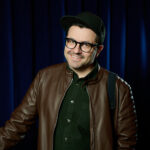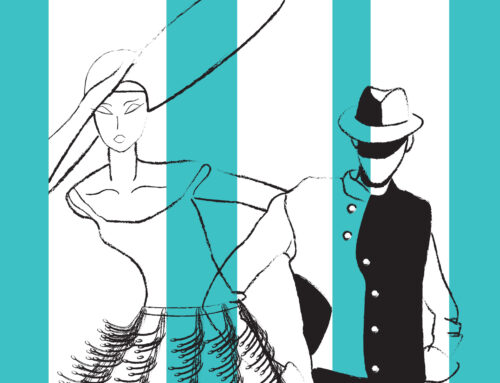Writing & Photography by Justin Negard
It’s a hot day on Roosevelt Avenue. The midday sun beams between the slats of the elevated train tracks, casting stripes of shadows across the sidewalk. Hot steam wafts from a nearby Colombian food cart as a man cooks strips of beef, peppers and onions on an open grill. He yells a few Spanish words to a nearby friend over the buzzing of his gas generator, then he tosses a couple of arepas on the grill.
A few feet away, the door to a Nepali restaurant swings open as a thick swirl of Szechuan peppers and garlic emanates into the summer air. The smells of the Colombian food cart mix with the spicy Nepalese seasoning. Something new emerges.
The 7 train rumbles overhead.
In Queens, something new is nothing new. With a population of over two million people, this New York City borough boasts 90 different neighborhoods and over a hundred different languages spoken, according to the Endangered Language Alliance (ELA). A visit to places like Astoria, Elmhurst or Forest Hills offers a glimpse into the diverse cultures of the people who live in those communities, united perhaps only by a shared hatred of rush hour traffic.
However, according to the New York State Comptroller’s Office, Jackson Heights and Flushing are especially diverse, with large numbers of immigrants from India, China, Peru, Bangladesh and many other countries all sharing what amounts to only a couple of miles of real estate. It is this unofficial sociological experiment that created Queens as we know it today: an amalgamation of countries, cultures, cuisines and religions only a stone’s throw from Westchester.

Jackson Heights
There is a wall of graffiti on 76th Street. “Queens get the Money” is painted in bright blue and orange colors, an homage to the local New York Mets, who play just down the street in Citi Field. If there is one consistent flag being flown within Queens, it’s likely for The Mets.
Directly across the street, Jackson Heights native Sami Deeb is cooking in his Lebanese restaurant, El Toum. For 40 years, this Beirut native has been serving baba ganoush and falafel to his neighbors.
“Jackson Heights is simply the whole world,” says Deeb. “Whatever you feel like is right here. It’s a great, diverse community.”
He continues talking from behind the counter, pointing his finger in every direction.
“If you go west, you’ve got a lot of South Americans. Go east, and you’ve got South Asians. Go north, and you’ll get a lot of Tibetans. We’re all mixed together, and we all get along.”
Head one block south, and you’ll find Roosevelt Avenue. One of the two main arteries for Jackson Heights, Roosevelt is the busier side of the neighborhood. It’s crowded, smokey and, for many, far from picturesque. It’s also a very busy spot for international cuisine.
In between the Bangladeshi pharmacies and Dominican salons, you will find many Ecuadorian bakeries and Mexican taquerias. Or you can go around the corner to Laliguras, a Nepali restaurant with a name that means “red rhododendron,” a symbolic flower of Nepal. In this establishment, they are proud of their thali dishes, which are sampler platters of signature South Asian dishes with a variety of protein options and sides of rice, lentils, curry, pickle, and crispy papad. Wash it down with a mango lassi (fruit and yogurt drink) and a side of momos (dumplings) for a complete meal.
If you travel east on Roosevelt, and you might find Venezuelan food trucks, such as Veneland, that sell a variety of arepas, including chicken, pork, cheese and more, along with a few original dishes that are influenced by Venezuela and the other cultures in the neighborhood.
“Venezuelan arepas have a different flavor than other countries,” says Brayan in his native Spanish. “But a lot of people also like our shawarma de pollo, which features shawarma-style chicken and spices that are popular with many of the Arab people in our neighborhood.”
Again, something new emerges.
Head to Northern Boulevard for a slightly quieter side of Jackson Heights. Latin grocery stores such as Mi Tierra Supermarket offer Malta (a bit like root beer), canela Mexicana (Mexican cinnamon) and flor de Jamaica (Jamaican flower), among other products not often found in our local supermarkets.
Jose Castro, the owner of The Empanada Spot on Northern Boulevard, is proud of two things: his Hispanic community and the New York Knicks.
“This part of Jackson Heights is home to so many Latinos,” says Castro. “Colombianos, Peruanos, Ecuatorianos, Paraguayos, Mexicanos and so many more. It’s a small world within New York. We all have our doors open and welcome anyone to come in.”

Flushing
There’s a man from China who calls himself Night. He works at Project KE, a self-described “anime club” in Flushing at the corner of Main Street and Northern Boulevard.
“Flushing is obviously Chinatown,” says Night. “There’s some Korean people, some Arab people, but the Chinese community gets bigger and bigger here.”
Located only a few minutes east of Jackson Heights, Flushing has become an increasingly important community for Asian people immigrating to New York City. Populations from all over Southeast Asia are represented here.
Head south on Main Street, and you will cut through the heart of Flushing. Bubble tea shops are plentiful, along with Taiwanese bakeries serving milk bread and taro cake. Buddhist temples particularly stand out with their ornate statues and red and gold decor adorning the entrance.
Fruit and vegetable markets are plentiful on nearly every block, offering produce not easily found in the Westchester region. US 1 Supermarket is one of the bigger shops in the neighborhood. The aisles are lined with huge displays of Chinese eggplant, choy sum (lettuce), sponge gourd, lotus root, Shanghai yangchun noodles and a great deal more. If you can deal with the crowds of shopping carts and elbows, it’s worth a visit.
Tangram is one of several new complexes popping up throughout Flushing. The building provides residential and retail in one location, and it has become a hub for entertainment and culture in the neighborhood. This includes an especially large shopping mall on the ground floor filled with coffee shops, a movie theater, and an abundance of Hello Kitty dolls and Dragonball merchandise, among other items.
The Kura revolving sushi bar is a popular Japanese dinner option. The restaurant includes a conveyor belt that snakes alongside every table in the restaurant, offering sushi and sashimi right at customers’ fingertips.
Meanwhile, if Blade Runner had a food court, the Tangram food hall and beer garden would be it. Designed as a futuristic Asian outdoor market, the food hall includes a neon-clad Vietnamese sandwich shop, a specialty dumpling stand, Korean hot dogs and more. Head to Hoi Polloi, the industrial beer garden located in the back of the hall, for craft brews and a slightly more adult-oriented vibe.
Based on sheer numbers and what the locals have to say, hot pots are one of the true culinary favorites throughout Flushing. They’re everywhere. This family-style soup cooks in the center of the table, allowing for additional ingredients and flavors to be tossed into the pot during the meal. Those who cry at the site of peppers would do well skipping the hot pot dinner. Spicy is an understatement.
Just scratching the surface
Visiting Queens is neither a trip to Nepal nor a meal in Colombia, but it’s a start. It’s a chance to step outside the comfort zone of your local town and be exposed to a different culture, if only for a few hours.
For some, this could inspire a new trip and a new adventure. For others, it may simply be an evening having a good meal while listening to a woman on Main Street playing the bowed strings of a Chinese erhu, the high-pitched, delicate sound echoing through the air while a reggaeton beat blends in from a passing car and the 7 train rumbles by yet again.

A bit of culture
For art lovers, Hudson quite literally has galleries in all directions, and far too many to properly list here. The recently transplanted Robin Rice Gallery has exchanged its Manhattan footprint to focus exclusively on the Hudson scene. The newer, larger gallery, which is closer to the river, focuses on fine art and photography. Meanwhile, the Susan Eley Fine Art gallery maintains its Manhattan location, featuring a “salon-style” space that began as a “pandemic pop-up” and never left.
For an unconventional artistic experience, look no further than Basilica Hudson. Built in 1800 as a forge and foundry for steel railway wheels before housing a glue factory, it’s now a multidisciplinary art center that hosts events, exhibitions, films, an artist residency program, weekly concerts and more. This brick-walled industrial building deserves attention during any day trip to Hudson.
But there’s no reason to limit your art experience to the indoors, as long as the weather cooperates. Just 20 minutes away in Ghent, you’ll find Art Omi, a 120-acre sculpture and architecture park plus gallery (called the Newmark Gallery) that features works from contemporary artists and architects. With a range of large-scale installations in nature and rotating exhibitions in the Newmark Gallery, the park has more than 60 works on display, and pieces are regularly added or exchanged, so you’ll have a new experience each time you visit.
Head upstate
With the warmer months upon us, it’s a perfect time to make the trip to Hudson. Whether it’s a stopover on the way to your Catskills adventure or an afternoon visit with the family, Hudson is worth the time. Come hungry and curious. Hudson will provide the rest.

This article was published in the July/August 2024 edition of Connect to Northern Westchester.
Tangram Food Hall, 133-36 37th Ave, Flushing
No phone # available
35-62 76th St, Jackson Heights
(718) 440-9970
Tangram Food Hall, 133-36 37th Ave, Flushing
(929) 468-8688
37-63A 76th St, Jackson Heights
(929) 208-0029
8102 Northern Blvd, Jackson Heights
(718) 651-3485
36-12 Main St, Flushing
(347) 896-3931
133-33 39th Ave, Flushing
(718) 509-0588
84-17 Northern Blvd, Jackson Heights
(718) 726-1400
39-12 Main St, Flushing
(347) 896-3931
Veneland
It’s a food truck in Jackson Heights, so catch it where you can!
Justin is an award-winning designer and photographer. He was the owner and creative director at Future Boy Design, producing work for clients such as National Parks Service, Vintage Cinemas, The Tarrytown Music Hall, and others. His work has appeared in Bloomberg TV, South by Southwest (SXSW), Edible Magazine, Westchester Magazine, Refinery 29, the Art Directors Club, AIGA and more.
Justin is a two-time winner of the International Design Awards, American Photography and Latin America Fotografia. Vice News has called Justin Negard as “one of the best artists working today.”
He is the author of two books, On Design, which discusses principles and the business of design, and Bogotà which is a photographic journey through the Colombian capital.
Additionally, Justin has served as Creative Director at CityMouse Inc., an NYC-based design firm which provides accessible design for people with disabilities, and has been awarded by the City of New York, MIT Media Lab and South By Southwest.
He lives in Katonah with his wonderfully patient wife, son and daughter.








